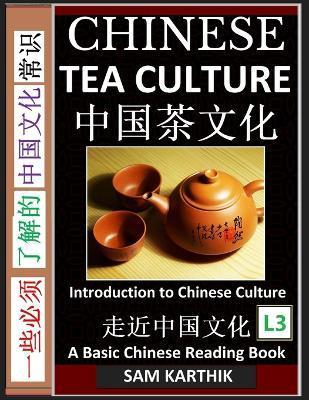Chinese Tea Culture Guide to Enjoying the World's Best Teas, Story of Ancient Tea Art, History and Drinking Ceremony (Simplified Characters with Pinyi

Chinese Tea Culture Guide to Enjoying the World's Best Teas, Story of Ancient Tea Art, History and Drinking Ceremony (Simplified Characters with Pinyi
Tea's origin story is a mix of folklore, myths and facts. According to the Chinese literature sources, the tea was accidentally discovered in Shaanxi province (in 2737 BCE) by the emperor and father of Chinese medicine, Shen Nong (神农帝). The early use of tea was recorded in the ancient Bashu (巴蜀) area (modern Sichuan Province). As early as the Western Han Dynasty (西汉), drinking tea in Bashu had become more common. Tea was often offered as a tribute to the emperors and imperial families. Although the tea culture existed long before the Tang Dynasty (唐朝), the tea was consumed in different ways. It wasn't until the appearance of the Tea Classic of Lu Yu (陆羽 《茶经》) in the Tang Dynasty that the way of drinking tea was changed. The tea culture further flourished in the Song Dynasty (宋朝). The existing Chinese tea culture (中国茶文化) represents the cultural characteristics formed during the tea drinking activities, including tea ceremony, tea virtue, tea spirit, tea book, tea set, tea painting, tea science, tea story, tea arts, and so on. Chinese tea culture combines the thoughts of Chinese Confucianism, Taoism, and Buddhism. Basically, China is the home of tea culture.
The current book volume, Chinese Tea Culture, is a Chinese reading practice book. It would introduce you to the very important concepts of the Chinese tea culture, such as the tea ceremony, drinking Customs, equipment, etc. The six most famous tea types (中国六大茶类), such as the Red Tea, Green Tea, White Tea, etc. are also discussed in detail. As such, all these concepts are very essential part of life in China. The new volume in the "Introduction to Chinese Culture Series", includes both the Chinese text (simplified characters) and pinyin. With about 1000 unique Chinese characters, the volume would be suitable for the beginners, lower intermediate and advanced level Chinese language learners (HSK 1-6). Overall, the reading series offers you a variety of elementary level books (Level 1/2/3) to learn Chinese culture as well as practice Chinese reading fast.
The book has 16 chapters in the following order: Chapter 1: History of Chinese Tea (第一章:中国茶史)Chapter 2: Lu Yu (第二章:陆羽)Chapter 3: Chinese Tea Culture (Ļ
PRP: 330.58 Lei
Acesta este Pretul Recomandat de Producator. Pretul de vanzare al produsului este afisat mai jos.
297.52Lei
297.52Lei
330.58 LeiLivrare in 2-4 saptamani
Descrierea produsului
Tea's origin story is a mix of folklore, myths and facts. According to the Chinese literature sources, the tea was accidentally discovered in Shaanxi province (in 2737 BCE) by the emperor and father of Chinese medicine, Shen Nong (神农帝). The early use of tea was recorded in the ancient Bashu (巴蜀) area (modern Sichuan Province). As early as the Western Han Dynasty (西汉), drinking tea in Bashu had become more common. Tea was often offered as a tribute to the emperors and imperial families. Although the tea culture existed long before the Tang Dynasty (唐朝), the tea was consumed in different ways. It wasn't until the appearance of the Tea Classic of Lu Yu (陆羽 《茶经》) in the Tang Dynasty that the way of drinking tea was changed. The tea culture further flourished in the Song Dynasty (宋朝). The existing Chinese tea culture (中国茶文化) represents the cultural characteristics formed during the tea drinking activities, including tea ceremony, tea virtue, tea spirit, tea book, tea set, tea painting, tea science, tea story, tea arts, and so on. Chinese tea culture combines the thoughts of Chinese Confucianism, Taoism, and Buddhism. Basically, China is the home of tea culture.
The current book volume, Chinese Tea Culture, is a Chinese reading practice book. It would introduce you to the very important concepts of the Chinese tea culture, such as the tea ceremony, drinking Customs, equipment, etc. The six most famous tea types (中国六大茶类), such as the Red Tea, Green Tea, White Tea, etc. are also discussed in detail. As such, all these concepts are very essential part of life in China. The new volume in the "Introduction to Chinese Culture Series", includes both the Chinese text (simplified characters) and pinyin. With about 1000 unique Chinese characters, the volume would be suitable for the beginners, lower intermediate and advanced level Chinese language learners (HSK 1-6). Overall, the reading series offers you a variety of elementary level books (Level 1/2/3) to learn Chinese culture as well as practice Chinese reading fast.
The book has 16 chapters in the following order: Chapter 1: History of Chinese Tea (第一章:中国茶史)Chapter 2: Lu Yu (第二章:陆羽)Chapter 3: Chinese Tea Culture (Ļ
Detaliile produsului









